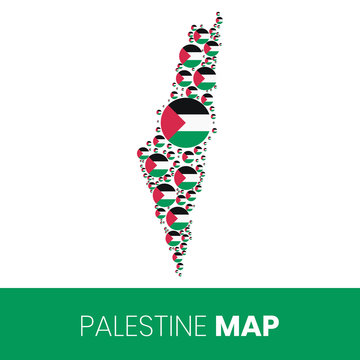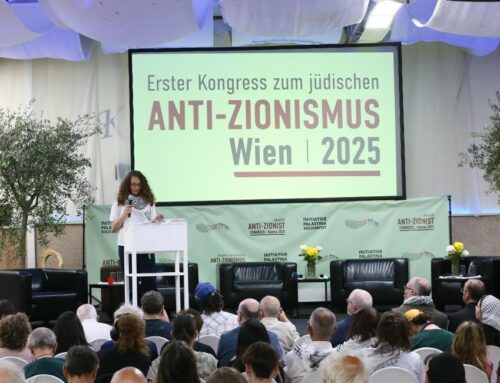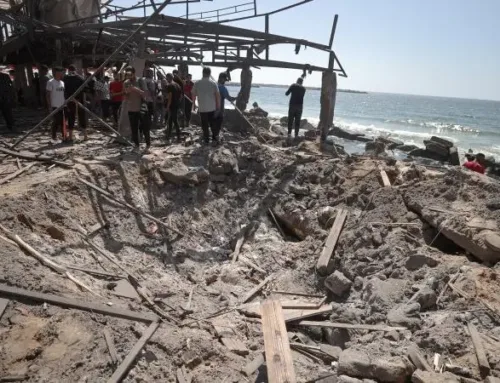Palestine: beyond the ‘two states’ myth
Tim Anderson
The persistent myth of a ‘two state’ solution for Israeli occupied Palestine is a cruel, 75 year old lie which has provided cover for the construction of a monstrous and genocidal apartheid regime. It blinds the international community to both the current reality and to the way forward.
UN resolutions on Palestine are badly outdated, frozen in a time where the ‘two states’ myth was more plausible and locked into a wording acceptable to the colony’s chief sponsors. Yet the only practical way forward, today, is the South African road: dismantling the apartheid regime.
That road is obscured by the ‘two states’ myth, as two former Israeli leaders have observed. Former Israeli Prime Minister Ehud Olmert (2007) recognised that “if the day comes when the [idea of a] two-state solution collapses and we face a South African-style struggle for equal voting rights”, then we will face an “apartheid like struggle … [and] the State of Israel is finished” (McCarthy 2007). Similarly, in 2017, another former Israeli PM Ehud Barak warned that the regime was “on a slippery slope” towards apartheid (Kaplan 2017).
Although the idea of ‘two states’ is embedded in UNSC resolutions – beginning with UNSC Resolution 242 of 1967 – that fact only highlights the failure of international resolutions to recognise changing realities. The Israelis have breached their obligations under Resolution 242 and there are now multiple independent reports branding the Israeli regime an apartheid state (CCHS 2022) and therefore a crime against humanity, which the international community has a responsibility to dismantle (Falk and Tilley 2017). Those reports are not yet recognised at the UN because key sponsors of the Israeli regime maintain veto power.
Fuller understandings are needed of this intractable conflict, which has serious regional and international repercussions. Without such understandings, practical efforts at resolution will be misguided. This paper aims to contribute to those understanding, in particular by putting to rest the ‘two state’ myth.
It is argued here that the “two state solution” and the idea of a “return to 1967 borders” is misleading and obscures the current reality and the likely future of Palestine, for these reasons:
- the ‘two state’ notion holds a fig leaf over the reality of a single apartheid regime;
- all the conditions set up by the UNSC (res. 242 and its successors) for a “return to 1967 borders” have been destroyed by the Israeli regime; and
- the apartheid Israeli regime must be dismantled, because a predatory, ethnic cleansing regime cannot co-exist with an independent Palestine.
Yet, as Washington and the Israelis understand very well, the distraction of ‘two states’ hides apartheid and prevents the construction of a broad anti-apartheid movement.
Any remaining possibility of ‘two states’ was finally destroyed by the constant Israeli theft of Palestinian land and the refusal to vacate annexed Lebanese and Syrian land. The idea of a “return to 1967 borders” simply hides the reality of an illegitimate apartheid regime.
1. A fig leaf to cover apartheid
The ‘two states’ idea covers this apartheid reality. The suggestion of ‘two states’ was raised as a recommendation at the United Nations in 1948 but no Israeli regime ever really supported it. The theory is still raised by some Israeli factions and by the US government, while other liberal Israelis have shifted to some version of a single democratic state (e.g. Beinart 2020; Levy 2023).
The founders of the Zionist colony wanted all of historic Palestine, or as much as they could seize. Zionist pioneer, the Austrian Theodor Herzl, said the Jewish colony would be part of “a rampart of Europe against Asia, an outpost of civilization as opposed to barbarism. We should as a neutral State remain in contact with all Europe, which would have to guarantee our existence” (Herzl 1896).
The majority view of a UN report on the ‘Future Government of Palestine’ (which did not include any Palestinians) formed the basis of UNGA resolution 181, which recommended the creation of an Arab state, a Jewish state and a ‘Special Regime’ of international status for Jerusalem (UNGA 1947). The population of Palestine in 1946 was 65% Arab and 33% Jewish, but the committee recommended that the area for the Jewish state be 55.5% of the total area of Palestine. Resolution 181 passed on 29 November 1947 with 33 votes in favour, 13 against and 10 abstentions (Hammond 2010; UNGA 1947). The British and the UN left the Zionist groups to carry out their ethnic cleansing (Pappe 2006). Contrary to popular myth, the UN did not “create” an Israeli state; UN members simply stood back and allowed the Zionists to seize land and purge entire populations.
In 1947-48 David Ben Gurion and his disciples were very clear that in creating their entity they would destroy entire villages, wipe out all resistance and expel the Arab populations “beyond the borders of the state” (Pappe 2006: Ch.4). Ben Gurion believed 80-90% of the British mandatory territory was needed and in 1947 declared that ‘only a state with at least 80% Jews’ would be ‘a viable and stable [Jewish] state’. His plans called for the killing of Palestinian political leaders, senior officials, inciters and financial supporters, the damaging of transport, water wells, mills, villages, clubs and cafes and expulsion of remaining Arab populations (Pappe 2006: xii-xiii, 26, 28, 48).
In 1988, as the first Intifada (uprising) was raging, Palestine Liberation Organisation (PLO) leader Yasser Arafat announced the PLO had accepted UN Resolutions 242 and 338, which seemed to grant Israel (actually “every state in the area”) an opportunity to “secure and recognised boundaries”, effectively recognising an Israeli state, so long as it withdrew its occupation of Arab lands (Damen 2022).
The Oslo Accords of the 1990s, based on resolution 242 (UNIP 1993: Art 1), raised hopes but what followed showed that the Israelis had used these agreements as a cover the expansion of illegal “settlements” in the occupied territories (Damen 2022). The Palestinian Authority (PA), set up as a temporary body pending establishment of a Palestinian state (PASSIA 2014: 4-5), then became effectively a municipality of the Israeli regime.
Yet the annexation of Palestinian land on the West Bank and in East Jerusalem actually increased under the Oslo regime (Damen 2022). Despite Israeli PM Rabin’s claim to ‘freeze’ the ‘settlements’, they grew due to a burst of investment in infrastructure (Helm 1993; Ogram 1995; Ofran 2020). Palestinians actually lost more land after recognition of the expanding Israeli regime and the creation of the PA.
The Trump ‘peace plan’ of 2020 held onto the two state myth while supporting the illegal annexations and trying to ‘normalise’ all other breaches of international agreements made by the Israelis, including attempts to permanently annex the occupied Syrian Golan, the destruction and theft of Palestinian homes in East Jerusalem and the unending construction of colonies across the West Bank (TWH 2020). In recent years these ‘settlements’ have grown so that there are more than 700,000 Israeli colonists on the West Bank. Despite muted international protests, Tel Aviv’s backing for this process makes it unlikely that the ‘settlers’ might (as was done in Gaza) simply be persuaded to pack up and go home.
Dissident but self-described “Israeli patriot” Gideon Levy (2023) says the Netanyahu regime, by its constant colonisation of the West Bank and East Jerusalem, has destroyed any possibility of two states. He observes there is a single apartheid state. “Not a single Israeli Prime Minister worked seriously to realize the [two state] solution … even the Oslo Accords turned out to be an empty promise … [we now have] one state with two regimes, a liberal democratic one in Israel [sic], which includes a discriminatory regime towards Palestinian citizens … and a South African style apartheid regime in the West Bank … the struggle [now is] over the nature of the regime in this one state” (Levy 2019). On that last part he is right.
2. International law? conditions for a “return to 1967 borders” have been destroyed by the Israelis
International law (Res. 242 and its successors) is often cited to justify the right of the Israeli regime to exist, ignoring the Israeli breaches of its obligations to withdraw from occupied land and ignoring the fact that they have never defined borders. All conditions set up by Res. 242 (1967) for a “return to 1967 borders” have been systematically destroyed by successive Israeli regimes, with the support of their Anglo American and European sponsors.
After the Zionist surprise attack on Arab states in 1967, and the occupation of the Palestinian West Bank, East Jerusalem, the Syrian Golan, parts of South Lebanon and the Egyptian Sinai, UN resolution 242 (1967) was passed with Israeli support because, while it called for an Israeli withdrawal from occupied territories, it also called on the Arab states to recognize an Israeli regime, under certain conditions.
The relevant text of UNSC resolution 242 called for:
“(i) Withdrawal of Israeli armed forces from territories occupied in the recent conflict;
“(ii) Termination of all claims or states of belligerency and respect for and acknowledgment of the sovereignty, territorial integrity and political independence of every State in the area and their right to live in peace within secure and recognized boundaries free from threats or acts of force” (UNSC 1967).
Since that time the Zionist entity (as it is called by the many Arab and Muslim states which do not recognise this entity as a state) only withdrew from the Egyptian Sinai (after a bilateral peace deal), then invaded Lebanon to destroy the PLO. Even after they were expelled from Lebanon (in 2000 and 2006) by the resistance group Hezbollah, they held onto some Lebanese lands, the Syrian Golan and then proceeded to consolidate their annexation of large parts of the West Bank and East Jerusalem.
The Israeli regime has violated the conditions of Res 242 so severely that it is arguable their suggested “right to live in peace within secure and recognised boundaries” has been abrogated; they never even tried to declared borders on their several frontier extensions. They similarly ignored UNGA Resolution 194 (1948) to allow Palestinian refugees a right to return. More importantly, the international branding of the Israeli state as an apartheid regime threatens to remove any state ‘rights’, other than the duty to dismantle apartheid (Falk and Tilley 2017).
Though there was some internal debate, the Israelis never intended to vacate the lands they occupied in 1967. The liberal side debated whether they should permanently seize between 40% and 80% of the West Bank while the openly fascist faction, led by Likud and Netanyahu, always wanted it all. The latter argument is often referred to the ‘Yinon Plan’ (Yinon 1982), a reiteration of older Zionist ambitions to create a ‘Greater Israel’, from “from the Brook of Egypt [the Nile River] to the Euphrates” (Herzl 1960: 711). This implies annexation of much more Syrian territory, beyond the Golan. On the liberal side, Labor Minister Yigal Allon argued that Israel carve the West Bank into an Israeli controlled strip along the Jordan river, with permanent Jewish colonies (‘settlements’) and army bases strategically placed across all the Palestinian territories. He added “the last thing we must do is to return one inch of the West Bank” (Auerbach 1991; Shlaim 2001). However, negotiation might be opened for a separate and subordinate Palestinian entity (Pedatzur 2007). In other words, both major Israeli factions were committed to rejection of most of Res 242 and to any notion of “1967 borders”.
Based on successive UNSC resolutions, the UN has not shifted from its position that the Palestinian residents of East Jerusalem, since 1967, are under belligerent occupation and are therefore protected by the 4th Geneva Convention (AIC 2011: 5-6). But this has not prevented their ongoing dispossession. Resolution 242 emphasised ‘the inadmissibility of the acquisition of territory by war’ (UNISPAL 1967). Disregarding this resolution, successive Israeli governments seized land using a range of methods: purchase under duress, seizure for state purposes, penal confiscations. The large number of feeder roads, military bases, fences and buffer zones also consumed more and more Arab land.
3. Confronting a predatory apartheid regime: illegal and incapable of co-existence
No expansionary, ethnic cleansing apartheid regime can be considered a legitimate state nor can it co-exist with an independent Palestinian state, the substance of which it has tried to devour. There are now six independent reports branding Tel Aviv an apartheid regime, meaning a crime against humanity which must be dismantled (CCHS 2022).
Formally speaking, while the Fatah dominated PA and PLO maintain allegiance to the Oslo Accords and to recognition of Israel as a state, that position was always conditional on the Israelis complying with their commitments (withdrawal from all occupied lands). It was always a position opposed by ‘rejectionist’ sections of the PLO (e.g. the PFLP), by the leadership of the Intifada movements and by the non PLO resistance groups (Hamas and Palestinian Islamic Jihad) which sprung up in the 1980s. Accepting 1967 boundaries implies abandoning of those Palestinians who were dispossessed before 1967.
Nevertheless, at a popular level the ‘two state’ idea has been popular amongst Palestinians, because it suggests independence from the occupying power. However in recent years West Bank Palestinians have turned away from two states towards the one single state, equal citizenship idea, probably because they are most intensely subject to the day to day realities of apartheid (JMCC 2021).
On the Israeli side, the Likud-led faction never had any intention of not seizing all historic Palestine, while the Labour side debated how much of the West Bank they wanted to annex. In other words they used Res. 242 to cover their expansionism. Yet Israeli and Jewish dissidents, alongside many Palestinians, now speak of the need of some version of a single democratic state (e.g. LFA 2023); that is, the South African path towards a post-apartheid single state.
The key problem for a legalist approach which stresses ‘two states’ and outdated UNSC resolutions is that the reality of an apartheid regime has been documented. The most authoritative report, prepared for the United Nations in 2017 but sidelined under political pressure, was written by US lawyers Richard Falk and Virginia Tilley. They spoke of an international duty to not recognise an apartheid regime and a positive duty to dismantle it.
Relevant excerpts from that report:
“Overwhelming evidence [shows] that Israel is guilty of the crime of apartheid. However only a ruling by an international tribunal … would make such an assessment truly authoritative … any delay compounds the crime by prolonging the subjugation of Palestinians to the active practice of apartheid by Israel. Prompt action is accordingly imperative to … end a crime against humanity that is being committed now” (Falk and Tilley 2017: s.3).
They called for an international tribunal to examine and rule on the matters subject of their findings. But they stressed these duties:
“States have a separate and collective duty (a) not to recognise an apartheid regime as lawful; (b) not to aid or assist a state in maintaining a apartheid regime; and (c) to cooperate with the United Nations and other states in bringing apartheid regimes to an end” (Falk and Tilley 2017: s.3).
Their report was preceded by one South African report and followed by reports from Britain (Amnesty), the USA (Human Rights Watch) and two from Palestine-Israel (CCHS 2022). The question of not providing aid to an apartheid regime undermines the assertion that the Israeli regime has some right to exist under international law. Many of the conditions studied in these reports (such as the ever expanding apartheid walls and fences in the West Bank) did not exist at the time of Resolution 242.
The Trump Peace Plan of 2020, which also sought to maintain the ‘two state’ myth, showed the awful reality of such a proposal in current circumstances. In what has been called “a monumental shift away from the already compromised international consensus” (Procter 2020), this proposal, which had zero Palestinian participation, spoke of “land swaps” where a Palestinian statelet would be offered parts of the Negev desert (south of Gaza) in exchange for the colonised parts of the West Bank. ON top of this, the Israeli regime would take the Jordan Valley, control all the borders and territorial waters, maintain security barriers, restrict even the Palestinian education system, continue to use the Palestinian Authority as a municipal agency and severely limit any return of Palestinian refugees (TWH 2020; JVL 2020; Procter 2020). In short, it was a plan for what apartheid South Africa called Bantustans (tribal homelands) under Apartheid administration. That dismal plan was rejected by the Palestinians; yet it is what is on offer to ‘two states’ supporters today.
And what about those states which refuse to recognise Israel? First there are the 20 or so Arab and Muslim states which have never recognised the Israeli regime. Then there are another 15 or so which broke relations, mostly after various massacres of Palestinians (WPR 2023). Three Arab states (UAE, Bahrain and Morocco) have since ‘normalised’ under US pressure. Saudi Arabia was talking about normalization but ended talks after the Palestinian Resistance offensive of October 2023.
Occupation and annexation, the construction of an apartheid regime and genocidal massacres have worn down the dream that there can be a simple division of land and “return” to borders and conditions that are not accepted by either side.
Those who continue argue the “legal” force of a “two state solution”, because of resolution 242 and its successors, will have to explain how and why they ignore the Israeli contempt for and rejection of the conditions of Res.242, and how they will then proceed to recognise a regime which is widely branded as a crime against humanity, as one of those two states.
We have been reminded that it is a crime to recognise an apartheid regime and to provide it with assistance (Falk and Tilley 2017). Although the apartheid brand is not yet embedded in UNSC resolutions, due to the UN influence of the regime’s sponsors, the legal implications of apartheid cannot be ignored.
In the meantime the ‘two states’ idea remains as a barrier to building an anti-apartheid movement, as is our duty under international law, so as to dismantle a racist regime, just as was done in South Africa, with equal citizenship for all alongside a just settlement on the matters of land and refugees.
———-
References
AIC (2011) ‘Jerusalem: facts and figures’, Alternative Information Center, December, Jerusalem and Beit Sahour, Palestine
Auerbach, Yehudit (1991) ‘Attitudes to an Existence Conflict: Allon and Peres on the Palestinian Issue, 1967-1987’, in Conflict Resolution, Vol 35 Issue 3, pp. 519-54, DOI: 10.1177/0022002791035003006
Beinart, Peter (2020) ‘I No Longer Believe in a Jewish State’, New York Times, 8 July, online: https://www.nytimes.com/2020/07/08/opinion/israel-annexation-two-state-solution.html
CCHS (2022) ‘SIX (6) important reports on Israeli Apartheid’, Centre for Counter Hegemonic Studies, online: https://counter-hegemonic-studies.site/israeli-apartheid-6/
Damen, Rawan (2022) ‘The Price of Oslo’, Palestine Remix, Al Jazeera, online: https://remix.aljazeera.com/aje/PalestineRemix/the-price-of-oslo.html#/14
Falk, Richard and Virginia Tilley (2017) Israeli Practices towards the Palestinian People and the Question of Apartheid’, CCHS, online: https://counter-hegemonic-studies.site/pal-apartheid-ft/
Helm, Sarah (1993) ‘Settlements mushroom despite Rabin’s pledge: Israeli building projects in the occupied territories boom in defiance of the US’, The Independent, 18 March, online: https://www.independent.co.uk/news/world/settlements-mushroom-despite-rabin-s-pledge-israeli-building-projects-in-the-occupied-territories-boom-in-defiance-of-the-us-1498355.html
Herzl, Theodor (1896) The Jewish State, Jewish Virtual Library, online: https://www.jewishvirtuallibrary.org/quot-the-jewish-state-quot-theodor-herzl
JMCC (2021) ‘“Palestinians in the West Bank favor one bi-national state over a two-state solution”, Poll NO 98, October, online: http://www.jmcc.org/documents/Jmcc98En_M2211.pdf
JVL (2020) The Trump Peace Plan — Peace to Prosperity’, 28 January, Jewish Virtual Library, online: https://www.jewishvirtuallibrary.org/peace-to-prosperity-the-trump-peace-plan
Kaplan, Allison (2017) ‘Ehud Barak Warns: Israel Faces ‘Slippery Slope’ Toward Apartheid’, Haaretz, 21 June, online: https://www.haaretz.com/israel-news/2017-06-21/ty-article/ehud-barak-warns-israel-on-slippery-slope-to-apartheid/0000017f-ef8b-d0f7-a9ff-efcf52ce0000
Levy, Gideon (2019) ‘One state, two nations’, Palestine Israel Journal, Vol 24 No 1, online: https://www.pij.org/articles/1906/one-state-two-nations
Levy, Gideon (2023) ‘Kaplan street must realise there’s no longer such thing as the occupation, it’s already one state’, Haaretz, 13 August, online: https://www.haaretz.com/opinion/2023-08-13/ty-article-opinion/.premium/kaplan-st-must-realize-theres-no-longer-such-thing-as-occupation-its-already-one-state/00000189-eaf4-d9cf-a7eb-fbffb9080000
LFA (2023) ‘A Land for All: from conflict to reconciliation’, online: https://www.alandforall.org/wp-content/uploads/2021/02/booklet-english.pdf
McCarthy, Rory (2007) ‘Israel risks apartheid-like struggle if two-state solution fails, says Olmert’, The Guardian, 30 November, online: https://www.theguardian.com/world/2007/nov/30/israel
Ofran, Hagit (2020) ‘The puzzle of Rabin, Oslo and the settlements’, Times of Israel, 9 November, online: https://blogs.timesofisrael.com/rabin-oslo-and-the-settlements/
Ogram, Peter (1995) ‘Settlement Expansion, MERIP, July-August, online: https://merip.org/1995/07/settlement-expansion/
Olmert, Ehud (2007) ‘Olmert to Haaretz: Two-state Solution, or Israel Is Done For’, Haaretz, 29 November, online: https://www.haaretz.com/1.4961269
Pappe, Ilan (2006) The Ethnic Cleansing of Palestine, Oneworld, Oxford
PASSIA (2014) ‘PLO vs PA’, Palestinian Academic Society for the Study of International Affairs, Jerusalem, September, online: http://passia.org/media/filer_public/8a/e7/8ae7c030-ac1d-4688-b3f4-606fbd50cd41/pa-plo2.pdf
Pedatzur, Reuven (2007) ‘The ‘Jordanian Option,’ the Plan That Refuses to Die’, Haaretz, 25 July, online: https://www.haaretz.com/1.4954947
Procter, Caitlin (2020) Nothing about this is a peace plan: a brief introduction, Middle East Directions, 30 January, online: https://blogs.eui.eu/medirections/nothing-peace-plan-brief-introduction/
Shlaim, Avi (2001) The Iron Wall, W. W. Norton Company, New York
TWH (2020) ‘Peace to prosperity: A Vision to Improve the Lives of the Palestinian and Israeli People’, Trump White House, online: https://trumpwhitehouse.archives.gov/wp-content/uploads/2020/01/Peace-to-Prosperity-0120.pdf
UNGA (1947) ‘Resolution 181 (II). Future government of Palestine’, United Nations General Assembly, 29 November, online: https://unispal.un.org/DPA/DPR/unispal.nsf/0/7F0AF2BD897689B785256C330061D253
UNIP (1993) Declaration of Principles on Interim Self Government Arrangements, September 13, 1993 [Oslo Accords], United States Institute of Peace, online: https://www.usip.org/sites/default/files/file/resources/collections/peace_agreements/oslo_09131993.pdf
UNISPAL (1967) ‘Security Council: Resolution 242 (1967) of 22 November 1967, United Nations: Question of Palestine, online: https://unispal.un.org/DPA/DPR/unispal.nsf/0/7D35E1F729DF491C85256EE700686136
UNSC (1967) Resolution 242 (1967) , S/RES/242, 22 November, online: https://www.securitycouncilreport.org/un-documents/document/ip-s-res-242.php
WPR (2023) ‘Countries that Recognize Israel 2023’, World Population Review, online: https://worldpopulationreview.com/country-rankings/countries-that-recognize-israel
Yinon, Oded (1982) ‘A Strategy for Israel in the Nineteen Eighties’, Redress Online, (Originally in Hebrew in KIVUNIM (Directions), A Journal for Judaism and Zionism, Issue No 4, Winter 5742, February 1982), online: http://www.redressonline.com/wp-content/uploads/2016/03/A-Strategy-for-Israel-in-the-Nineteen-Eighties-Oded-Yinon.pdf






Leave A Comment